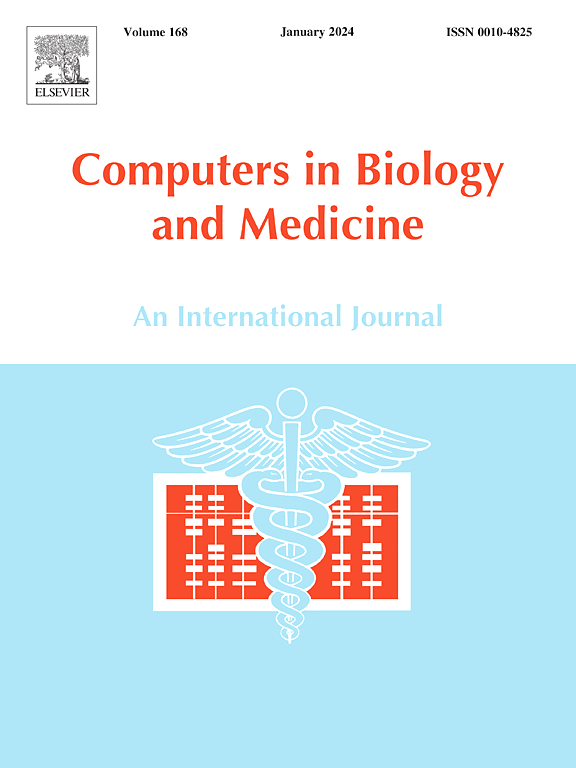用于肝转移性结肠癌术中像素分类的高光谱成像数据集和Grassmann流形方法
IF 6.3
2区 医学
Q1 BIOLOGY
引用次数: 0
摘要
高光谱成像(HSI)在改变计算病理学领域具有重要的潜力。然而,基于HSI的研究数量仍然有限,并且在许多情况下,HSI优于传统RGB成像的优势尚未得到最终证明,特别是对于术中收集的标本。为了解决这些挑战,我们提出:(i)一个数据库,包括27个hsi的苏木精-伊红染色冷冻切片,收集自14例结肠癌转移到肝脏的患者。目的是验证术中肿瘤切除术的逐像素分类;(ii)结合Grassmann点和最近子空间分类器的hsi逐像素分类方法。在450nm - 800nm的光谱范围内获得hsi,分辨率为1nm,得到1384 × 1035像素的图像。像素级注释由两名病理学家和一名医学专家进行。为了克服实验可变性和缺乏注释数据等挑战,我们将Grassmann流形(GM)方法与张量奇异谱分析(TSSA)方法提取的光谱空间特征相结合,对230 × 258像素的非重叠斑块进行了分析。GM-TSSA方法在HSI数据集上仅使用1%的标记像素,获得了0.963的微平衡精度(BACC)和0.959的微f1分数。GM-TSSA方法优于使用63%标记像素训练的六种深度学习架构。数据可在:https://data.fulir.irb.hr/islandora/object/irb:538,代码可在:https://github.com/ikopriva/ColonCancerHSI。本文章由计算机程序翻译,如有差异,请以英文原文为准。

A hyperspectral imaging dataset and Grassmann manifold method for intraoperative pixel-wise classification of metastatic colon cancer in the liver
Hyperspectral imaging (HSI) holds significant potential for transforming the field of computational pathology. However, the number of HSI-based research studies remains limited, and in many cases, the advantages of HSI over traditional RGB imaging have not been conclusively demonstrated, particularly for specimens collected intraoperatively. To address these challenges we present: (i) a database consisted of 27 HSIs of hematoxylin-eosin stained frozen sections, collected from 14 patients with colon adenocarcinoma metastasized to the liver. It is aimed to validate pixel-wise classification for intraoperative tumor resection; (ii) a novel method which combines Grassmann points with nearest subspace classifier for pixel-wise classification of HSIs. The HSIs were acquired in the spectral range of 450 nm–800 nm, with a resolution of 1 nm, resulting in images of 1384 × 1035 pixels. Pixel-wise annotations were performed by two pathologists and one medical expert. To overcome challenges such as experimental variability and the lack of annotated data, we applied Grassmann manifold (GM) approach in combination with spectral-spatial features extracted by tensor singular spectrum analysis (TSSA) method to non-overlapping patches of 230 × 258 pixels. Using only 1 % of labeled pixels per class, the GM-TSSA method achieved a micro balanced accuracy (BACC) of 0.963 and a micro F1-score of 0.959 on the HSI dataset. The GM-TSSA approach outperformed six deep learning architectures trained with 63 % of labeled pixels. Data are available at: https://data.fulir.irb.hr/islandora/object/irb:538, and code is available at: https://github.com/ikopriva/ColonCancerHSI.
求助全文
通过发布文献求助,成功后即可免费获取论文全文。
去求助
来源期刊

Computers in biology and medicine
工程技术-工程:生物医学
CiteScore
11.70
自引率
10.40%
发文量
1086
审稿时长
74 days
期刊介绍:
Computers in Biology and Medicine is an international forum for sharing groundbreaking advancements in the use of computers in bioscience and medicine. This journal serves as a medium for communicating essential research, instruction, ideas, and information regarding the rapidly evolving field of computer applications in these domains. By encouraging the exchange of knowledge, we aim to facilitate progress and innovation in the utilization of computers in biology and medicine.
 求助内容:
求助内容: 应助结果提醒方式:
应助结果提醒方式:


